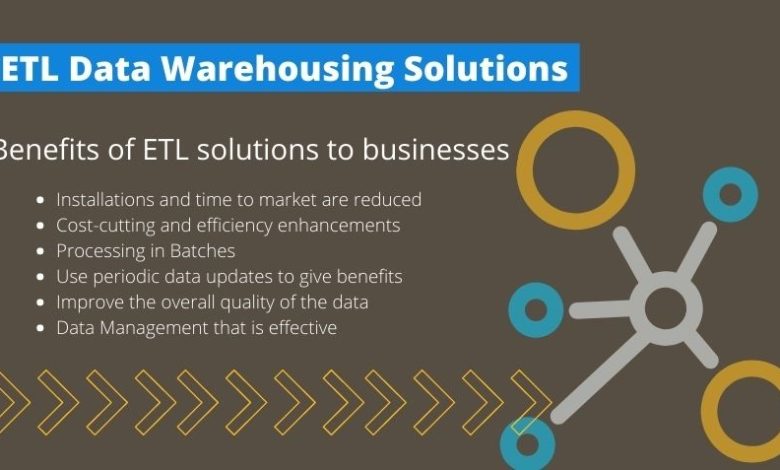Businesses Rely on ETL Data Warehousing Solutions Capabilities: Are they really scalable?



It is common knowledge among businesses that they have valuable information dispersed across their firm networks that requires consolidation and analysis, and that if this knowledge is not collected and consolidated, it would become useless. The difficulty is that this data is kept in a number of different systems and codecs, which complicates matters. Furthermore, various systems are the potential of using a variety of distinct defining approaches.
Extraction, transformation, and loading (ETL) software is the most effective approach in this situation. The features of this program, according to its name, including taking data from a source, cleaning and structuring it, and then sending it to a destination where it may be used efficiently and effectively.
Among other services, the core of ETL data warehousing solutions includes consultancy, development, validation & deployment, managing, and management, among other things. They use a consultative approach to delivering IT solutions services, that distinguishes us from the competition. This strategy guarantees that we give a targeted and totally personalized solution to clients that is tailored to their specific circumstances and need.
Benefits of ETL solutions to businesses
- Installations and time to market are reduced
In a constantly evolving marketplace where supply cycle time is critical, transferring apps and services to the cloud means that they be deployed more quickly. When firms provide servers instead of purchasing and configuring them, the deployment of services and applications is more rapid and straightforward.
Additionally, firms may test and roll out new business apps with incredible simplicity and speed in the cloud, guaranteeing that development can continue unabated.
- Cost-cutting and efficiency enhancements
A strong motivation for a corporation to switch to cloud services is the substantial amount of money that may be saved. For example, auto-scaling is a fantastic approach to optimize cloud services, and a few cloud service providers do really give this feature to their customers. This implies that businesses only pay for the services that they really utilize. They can scale up and down as required, without incurring the costs associated with maintaining equipment up and running even outside of peak demand periods, which would otherwise be incurred. When services are necessary, companies provide them as needed, and then switch them off when they are no longer required.
- Processing in Batches
The major ETL procedure was traditionally performed on-premises using batch processing. Processing huge data sets used to tax an organization’s computer resources, therefore these operations were carried out in batches during off-hours. However, this is no longer the case. Despite the fact that today’s ETL tools can still do batch processing, they are less confined in terms of when and how rapidly the processing happens since they are often hosted in the cloud.
- Use periodic data updates to give benefits
Aside from cutting down on the amount of data input required during the ETL data warehousing implementation phase, adopting continuous data updates may help to accelerate the integration process. This implies that when your data sets are changed, you simply need to add the new data to your ETL pipeline, rather than changing all of the previous data and having to start over from the beginning of the process. Incorporating progressive data updates into an ETL integration solution might be difficult, but the effort is well worth it in the long run.
- Improve the overall quality of the data
When it comes to ETL data warehousing integration, the old proverb data in and day out holds true. Maintaining the highest level of cleanliness in the data you enter into your ETL operations can help you achieve faster and more reliable ETL outputs. The use of automated information quality tools may assist you in this endeavor by discovering issues such as missing or contradictory data within existing data sets.
Not only must data sets be cleaned prior to ETL integration, but quality management maintenance must also be performed on an ongoing, continuous basis in order to achieve the greatest possible level of data quality.
- Data Management that is effective
Functionalities such as REST APIs and Any-to-Any communication help to support data management activities. APIs aid in the successful administration of data by combining data from an existing system with data from the clouds, the web, and other applicable data sources. This even improves the present integration architecture while also optimizing the general resources.
Bottom Line
The environment in which they function, on the other hand, is something that all companies have in common. In an increasingly computerized, synchronized, and competitive world, it is important to remember that everything is connected. Making the decision to choose the best all-in-one business management ETL Solutions for your company will help you remain one step ahead of the competition.



